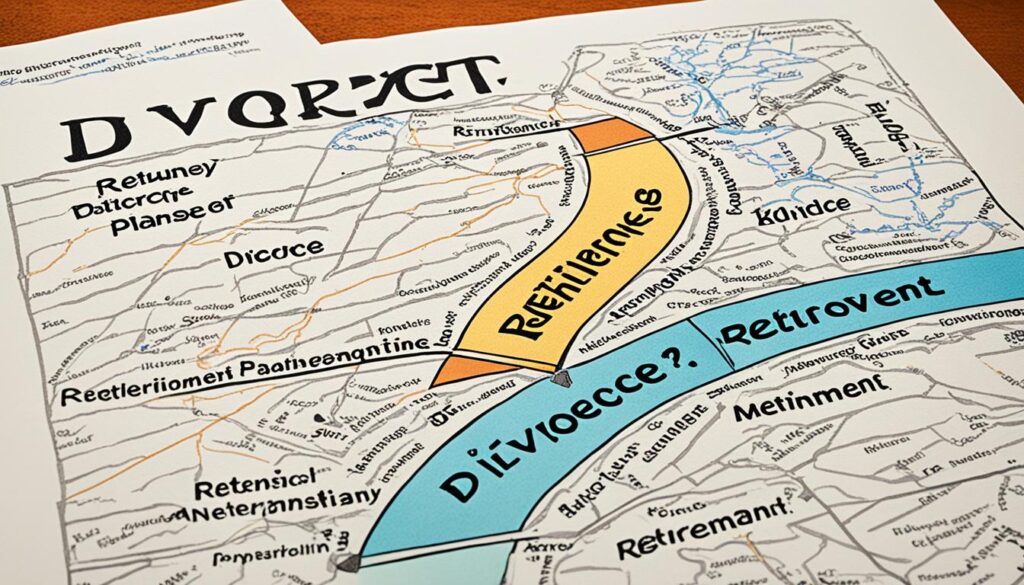Did you know that around 40-50% of marriages in the United States end in divorce? While couples deal with the emotional and practical aspects of separation, it’s important not to neglect the substantial effect it can have on retirement planning. Taking proactive measures to reevaluate and modify your retirement strategy is essential for securing financial stability in your later years.

After divorce, it is essential to create a new financial plan for retirement. This involves assessing your current expenses, estimating your retirement income needs, and adjusting your investment strategy accordingly. Consider replacing 70% to 90% of your pre-retirement income. If you have guaranteed benefits like Social Security, aim for 70%; otherwise, aim for 90%. Consulting a certified financial planner can help you create a retirement plan tailored to your needs and goals.
Key Takeaways:
- Divorce can have a significant impact on retirement planning.
- Assess your current expenses and estimate your retirement income needs.
- Consider replacing 70% to 90% of your pre-retirement income.
- Consult a certified financial planner to create a personalized retirement plan.
- Adjust your investment strategy based on your post-divorce financial goals.
Making a New Retirement Plan
When going through a divorce, it is crucial to reassess your retirement plans and make necessary adjustments to secure your financial future. Creating a new retirement plan involves evaluating your retirement income needs, defining clear retirement goals, and developing a strategic investment strategy.
One of the first steps in making a new retirement plan is to determine your retirement income requirements based on your current expenses and any potential changes that may arise post-divorce. Consider factors such as downsizing your living arrangements or the desire to increase your travel plans.
Setting clear retirement goals is essential to ensure you have a roadmap for achieving the lifestyle you desire. Whether it’s maintaining your current standard of living or fulfilling long-held retirement dreams, clearly defining your goals will help guide your financial decisions.
Once you have established your retirement goals, the next step is to develop an investment strategy that aligns with your objectives. This may involve diversifying your investment portfolio, seeking out low-cost investment options, and regularly reviewing and adjusting your strategy as needed.

While navigating the complexities of divorce and retirement planning, it is highly recommended to seek professional guidance from a certified financial planner. A financial expert can provide personalized advice, assess your unique circumstances, and help you make informed decisions to maximize your retirement income, achieve your goals, and maintain financial security.
Here’s an example of a retirement income calculation:
| Monthly Expenses | Required Retirement Income |
|---|---|
| Mortgage/Rent | $1,500 |
| Utilities | $300 |
| Healthcare | $400 |
| Food | $500 |
| Transportation | $200 |
| Entertainment | $300 |
| Total Expenses | $3,200 |
Based on these monthly expenses, you would need a retirement income of at least $3,200 per month. This calculation serves as a starting point for determining your retirement income needs. By working with a certified financial planner, you can further refine this calculation and create a personalized retirement plan that aligns with your goals and financial situation.

Getting Your 401(k) Together
Contributing to a 401(k) can be a valuable way to build your retirement portfolio. A 401(k) is a retirement plan offered by many employers and may also be available for self-employed individuals. Take advantage of the tax benefits offered by a 401(k), including pre-tax contributions and tax-free growth until retirement.
If your employer offers a matching contribution, be sure to contribute at least up to the maximum matching amount to maximize this benefit. The employer match is essentially free money that can significantly boost your retirement savings. For example, if your employer matches 50% of your contributions up to 6% of your salary, and you earn $50,000 per year, contributing at least $3,000 (6% of your salary) would result in an additional $1,500 from your employer.
Remember, the more you contribute to your 401(k), the more your retirement portfolio can grow over time. Even small contributions can make a significant impact thanks to the power of compound interest. It’s crucial to start early and consistently contribute to your 401(k) throughout your career to maximize its benefits.
When selecting investment options for your 401(k), consider your risk tolerance and investment goals. Diversifying your portfolio by investing in a mix of stocks, bonds, and other assets can help mitigate risk and maximize potential returns. If you’re unsure about which investments to choose, consult with a financial advisor or utilize resources provided by your employer.

The Benefits of a 401(k)
A 401(k) offers several advantages that can enhance your retirement savings. Here are some key benefits:
- Pre-tax contributions: Contributions to a traditional 401(k) are made with pre-tax dollars, which means they can lower your taxable income for the year. This can result in immediate tax savings.
- Tax-free growth: Any investment gains within your 401(k) account grow tax-free until you withdraw the funds during retirement. This allows your savings to compound over time, potentially resulting in significant growth.
- Automatic contributions: Most 401(k) plans allow you to set up automatic contributions directly from your paycheck. This convenient feature helps you stay on track with your retirement savings goals.
- Higher contribution limits: Compared to other retirement accounts, such as IRAs, 401(k) plans generally have higher contribution limits. For 2021, individuals can contribute up to $19,500 to their 401(k) accounts, with an additional $6,500 catch-up contribution for those aged 50 or older.
By taking advantage of these benefits and regularly contributing to your 401(k), you can build a substantial retirement portfolio that provides the financial security you desire during your golden years.
| 401(k) Plan | Employer Match | Contribution Limit |
|---|---|---|
| Company A 401(k) | 50% match on contributions up to 6% of salary | $19,500 (plus $6,500 catch-up contribution) |
| Company B 401(k) | 100% match on contributions up to 4% of salary | $19,500 (plus $6,500 catch-up contribution) |
| Company C 401(k) | No employer match | $19,500 (plus $6,500 catch-up contribution) |
Opening an IRA
If you don’t have access to a 401(k) or want to save more for retirement, consider opening an Individual Retirement Account (IRA). An IRA is a popular retirement account that offers tax advantages and allows you to invest in various assets such as stocks, bonds, and mutual funds. It’s a great way to grow your retirement savings and take control of your financial future.
With an IRA, you have two main options: a traditional IRA or a Roth IRA. A traditional IRA allows you to make tax-deductible contributions, meaning you don’t pay taxes on the money you contribute until you withdraw it in retirement. On the other hand, a Roth IRA offers tax-free growth and tax-free withdrawals in retirement, as long as you meet certain criteria.
When opening an IRA, it’s important to be aware of the contribution limits set by the IRS. For the 2018 tax year, the maximum contribution for both traditional and Roth IRAs is $5,550 ($6,500 for individuals aged 50 or older). These limits are subject to change, so it’s always a good idea to check with the IRS or consult a financial advisor for the most up-to-date information.
Before choosing between a traditional or Roth IRA, it’s crucial to consider your current financial situation, tax bracket, and retirement goals. A financial advisor can help you assess your options and make an informed decision based on your individual circumstances.

Traditional IRA
A traditional IRA is a tax-deferred retirement account that allows you to contribute pre-tax income. This means that the money you contribute is deducted from your taxable income for that year, potentially lowering your overall tax bill. The funds in your traditional IRA will grow tax-free until you start making withdrawals in retirement.
One key advantage of a traditional IRA is that it provides an immediate tax benefit. However, keep in mind that when you withdraw the funds in retirement, you will pay income taxes on the amount withdrawn. This makes traditional IRAs a good option if you expect to be in a lower tax bracket during retirement.
Roth IRA
A Roth IRA is a retirement account that allows you to contribute after-tax income. While you don’t get an immediate tax break when you contribute, all qualified withdrawals from a Roth IRA are tax-free, including both the original contributions and the earnings on those contributions.
Roth IRAs are ideal if you expect to be in a higher tax bracket during retirement or if you want to enjoy tax-free growth on your investments. Additionally, Roth IRAs do not have any required minimum distributions (RMDs), which means you can leave the funds in the account to grow for as long as you like.
Whether you choose a traditional IRA or a Roth IRA, opening an IRA can be a valuable step towards building a secure retirement. It’s a versatile retirement account that offers tax advantages and investment flexibility, allowing you to tailor your retirement savings to your specific needs and goals. Take advantage of the contribution limits and consult with a financial advisor to make the most of your IRA.
Catching Up
As retirement age approaches, it’s not too late to boost your retirement savings. Catch-up contributions can be a game-changer for those aged 50 and older, offering an opportunity to make extra tax-deductible contributions to your retirement plan. By taking advantage of catch-up contributions, you can maximize your retirement savings and secure a more comfortable future.
One popular retirement plan that allows catch-up contributions is the 401(k). With a 401(k), you have the potential to contribute additional funds on top of the regular contribution limit. In 2018, the catch-up contribution limit for 401(k), 403(b), and 457(b) plans is $6,000. This means that if you’re eligible, you can contribute up to $24,500 in total ($18,500 regular contribution + $6,000 catch-up contribution) for the year.

These catch-up contributions can make a significant impact on your retirement savings, allowing you to bridge any gaps in your financial plan and build a more robust nest egg. By contributing additional funds to your retirement plan, you have the opportunity to take advantage of potential growth and compounding over time, potentially increasing your retirement savings even further.
In addition to the catch-up contributions available for 401(k) plans, catch-up contributions are also allowed for Individual Retirement Accounts (IRAs). However, the catch-up contribution limit for IRAs is lower than that of 401(k) plans, set at $1,000 for the tax year 2018. Consider opening an IRA and taking advantage of this opportunity for additional contributions to your retirement savings.
It’s important to note that catch-up contributions are designed to give individuals a chance to catch up on their retirement savings if they haven’t been able to contribute as much as they would like in previous years. This option is especially valuable for those who may have faced financial challenges in the past but are now in a better position to boost their retirement savings.
The Advantages of Catch-Up Contributions
There are several advantages to making catch-up contributions to your retirement plan:
- Accelerated savings: Catch-up contributions allow you to accelerate your retirement savings, giving you the opportunity to bridge any gaps in your financial plan and make up for lost time.
- Tax advantages: Catch-up contributions are tax-deductible, meaning you can potentially lower your taxable income for the year. This can result in immediate tax savings and may allow your contributions to grow tax-free until retirement.
- Higher contribution limits: Catch-up contributions raise the maximum amount you can contribute to your retirement plan, giving you the chance to save more for retirement than the regular contribution limits allow.
- Compound growth potential: By making catch-up contributions, you have the potential to take advantage of compound growth over time. This can result in significant growth in your retirement savings, helping you achieve a more secure financial future.
Keep in mind that catch-up contributions are subject to annual limits and may vary based on the type of retirement plan you have. It’s important to stay informed about the current contribution limits and eligibility requirements to ensure you maximize your retirement savings potential.
“Catch-up contributions can be a valuable tool for individuals nearing retirement age. By taking advantage of these additional contributions, you can significantly boost your retirement savings and increase your financial security in retirement.” – [Financial Advisor Name]
Consulting with a financial advisor or retirement planning specialist can help you determine the best course of action for your specific situation. They can provide personalized advice based on your retirement goals, income, and investment strategy.
Don’t let the feeling of being behind discourage you. Take advantage of catch-up contributions and take control of your retirement savings. With careful planning and informed decisions, you can enhance your financial well-being and enjoy a more secure retirement.
Talking to an Advisor
When it comes to navigating the complexities of retirement planning after divorce, seeking guidance from a financial advisor can be instrumental. Whether you need help creating a comprehensive retirement plan or understanding the intricacies of managing your finances post-divorce, a certified financial planner can provide the personalized advice you need to make informed decisions.
It’s important to select an advisor you trust and feel comfortable with, as they will play a significant role in managing your retirement plan and overall finances. A certified financial planner has undergone rigorous training and possesses the knowledge and expertise to guide you through the intricacies of retirement planning. They can help you assess your current financial situation, set realistic retirement goals, and develop a tailored plan to achieve them.
Working with a financial advisor offers several benefits. Firstly, they can provide you with an objective perspective on your financial situation. They will take into account your income, assets, debts, and other financial obligations to create a retirement plan that suits your unique needs and goals. Additionally, a financial advisor can help you maximize your retirement savings by recommending appropriate investment strategies and financial products.
Furthermore, a financial advisor can assist you in navigating complex financial matters such as division of retirement assets, tax implications, and considerations regarding Social Security benefits. They can help you make sense of the ever-changing financial landscape and provide strategies to protect and grow your retirement nest egg.
Benefits of Working with a Certified Financial Planner
- Expertise: A certified financial planner has in-depth knowledge and expertise in retirement planning and can provide valuable insights based on their comprehensive understanding of the subject.
- Personalized Advice: By thoroughly analyzing your financial situation, goals, and objectives, a financial planner can offer personalized advice tailored to your specific needs.
- Objectivity: A financial advisor can provide an objective viewpoint and help you make rational decisions based on your financial goals, rather than being swayed by emotions or market volatility.
- Continued Support: Working with a financial advisor is not a one-time interaction. They can provide ongoing support, regularly reviewing and adjusting your retirement plan to ensure it remains aligned with your changing circumstances and market conditions.
By choosing to work with a financial advisor, you are gaining a trusted partner who will prioritize your financial well-being and help you achieve your retirement goals. With their expertise and guidance, you can navigate the complexities of retirement planning with confidence and set yourself up for a secure and comfortable retirement.

The Impact of Divorce on Retirement Savings
Divorce can have a significant impact on your retirement savings. The financial implications of a divorce settlement can leave individuals in a vulnerable position when it comes to their retirement plans. It is crucial to understand the challenges that divorce can present and take steps to rebuild and secure your retirement funds.
Working with a financial advisor who specializes in divorce and retirement planning is key. They can help you reassess your retirement goals, adjust your savings strategies, and explore potential investment opportunities. By collaborating with a professional, you can develop a clear plan to ensure your financial security in retirement.
Rebuilding your retirement savings after a divorce settlement requires careful consideration and a focus on long-term financial planning. Depending on the circumstances of the divorce, such as the division of assets and potential alimony or child support payments, your retirement funds may be significantly impacted.
“Divorce can have long-lasting effects on your financial future, but it’s not the end of the road. Rebuilding your retirement savings is possible with the right strategies and guidance.” – John Smith, Certified Financial Planner
The Importance of Reassessing Your Retirement Goals
After a divorce, it is essential to reassess your retirement goals. The financial changes brought on by the divorce settlement may require adjustments to your retirement savings plans. Your financial advisor can help you analyze your current financial situation and determine the best course of action for rebuilding your retirement funds.
Adjusting Your Savings Strategies
Divorce often necessitates a shift in saving strategies. With potential changes in income and expenses, it is crucial to review and adjust the amount you contribute to your retirement savings. Your financial advisor can help you evaluate your cash flow, determine an appropriate savings rate, and identify any areas where you can cut back on expenses to maximize your retirement savings.
Exploring Potential Investment Opportunities
Divorce may require individuals to explore new investment opportunities to rebuild their retirement funds. By diversifying your investment portfolio and considering the potential return on investment, you can take steps towards rebuilding your retirement savings. Working closely with a financial advisor will ensure you make informed investment decisions based on your risk tolerance and long-term goals.
Remember that rebuilding your retirement savings after a divorce settlement takes time and patience. However, with a well-executed plan, ongoing support from a certified financial planner, and a commitment to your long-term financial wellbeing, you can regain financial stability and work towards a comfortable retirement.

| Key Points | |
|---|---|
| 1. Divorce can significantly impact retirement savings. | Reassessing retirement goals and seeking professional guidance is crucial. |
| 2. Adjust savings strategies to accommodate changes in income and expenses. | Identify areas to cut back on expenses and maximize retirement savings. |
| 3. Explore new investment opportunities to rebuild retirement funds. | Diversify your portfolio and consult with a financial advisor for informed decisions. |
Dividing Retirement Assets in a Divorce
During divorce proceedings, it is crucial to ensure a fair division of retirement assets between both parties. Dividing retirement accounts, such as 401(k)s and IRAs, requires careful consideration and adherence to specific legal requirements.
Qualified Domestic Relations Order (QDRO) for 401(k)s
For 401(k) plans, a Qualified Domestic Relations Order (QDRO) is necessary to specify how the funds will be divided between the spouses. A QDRO is a court order that outlines the division of the retirement account and ensures compliance with the Employee Retirement Income Security Act (ERISA). It determines each party’s share of the account and how funds will be allocated.
A QDRO is crucial to safeguard the interests of both spouses and prevent any tax or early withdrawal penalties. It is essential to consult with legal experts and a qualified financial advisor experienced in QDROs to ensure accurate and fair distribution of 401(k) assets.
Division of IRA Assets
Unlike 401(k)s, Individual Retirement Accounts (IRAs) do not require a QDRO for division. Instead, the division of IRA assets should be outlined in the divorce settlement agreement and filed with the plan custodian. This agreement specifies how the IRA funds will be allocated between the divorcing spouses.
Dividing IRA assets may require the assistance of legal and financial professionals to ensure compliance with IRS rules and regulations. Seeking expert guidance can help navigate the complexities of the process and avoid potential tax consequences.
Complexities in Dividing Pensions
Dividing pensions in a divorce can be complex due to various factors, such as plan rules, state laws, and whether payments have already begun. Pensions earned during the marriage are generally considered marital assets and subject to division.
It is essential to consult with professionals knowledgeable in pension division to ensure compliance with legal requirements and maximize both parties’ benefits. A financial advisor or attorney experienced in divorce proceedings can help analyze pension plans, assess the appropriate valuation, and determine the fair division of pension assets.

Seeking professional advice is crucial when dividing retirement assets during a divorce. Knowledgeable experts can guide you through the process, ensuring accurate asset division and safeguarding your long-term financial interests.
Social Security Benefits in Divorce
Social Security benefits can play a crucial role in retirement planning after a divorce. When navigating the complexities of divorce settlements, it is important to consider the impact of Social Security benefits on your financial future.
If the marriage lasted for at least ten years, an ex-spouse may be eligible to apply for monthly benefits based on the higher earner’s full retirement-age benefit. These ex-spousal benefits can be worth up to 50% of the higher earner’s benefit amount, providing an additional source of income for the receiving spouse.
It is vital to note that these benefits do not affect the higher-earning spouse’s benefits in any way. They are provided separately to the ex-spouse, based on their own earnings and Social Security contributions.
When negotiating a divorce settlement, it is essential to consider Social Security benefits as part of the overall financial equation. Properly accounting for these benefits can help ensure both parties have a fair and secure financial future.
After the divorce is finalized, it is crucial to update beneficiary designations and other financial planning documents to reflect the new circumstances. This includes reviewing and updating any existing Social Security beneficiary designations to ensure they align with your post-divorce financial plan.
Planning for retirement after a divorce can be complex, but understanding and maximizing your Social Security benefits can make a significant difference in your financial security during retirement.

Divorce and Social Security Benefits
In divorce cases, Social Security benefits can provide financial support to both parties involved. Here are a few key points to consider:
- Marriage duration: The marriage must have lasted for at least ten years for an ex-spouse to be eligible for ex-spousal benefits.
- Higher earner’s benefits: The ex-spouse can receive up to 50% of the higher earner’s full retirement-age benefit amount.
- Independent eligibility: Claiming ex-spousal benefits does not impact the higher-earning spouse’s benefits or eligibility in any way.
- Divorce settlement: Social Security benefits should be considered as part of the overall financial settlement in divorce negotiations.
Understanding the intricacies of Social Security benefits in divorce is crucial for effective retirement planning. It is highly recommended to consult with a certified financial planner or Social Security specialist to gain valuable insights and make informed decisions.
| Key Factors | Considerations |
|---|---|
| Marriage Duration | The marriage must have lasted for at least ten years for an ex-spouse to be eligible for ex-spousal benefits. |
| Rewards Percentage | The ex-spouse can receive up to 50% of the higher earner’s full retirement-age benefit amount. |
| Dependency Impact | Claiming ex-spousal benefits does not affect the higher-earning spouse’s benefits or eligibility. |
| Settlement Consideration | Social Security benefits should be factored into the overall financial settlement in divorce negotiations. |
Handling Inheritances in Divorce
The division of inheritances in divorce can be a complex process that requires careful consideration. How an inheritance is treated during divorce varies depending on the specific circumstances surrounding it. It is crucial to understand the implications and seek guidance from an estate specialist familiar with your state’s laws to ensure a fair distribution of inherited assets.
If an inheritance was fully kept separate and not commingled with shared funds, it may be treated as a separate asset in the divorce. This means that it could be excluded from the division of marital property and be retained by the individual who received the inheritance.
However, if the inheritance was deposited into shared accounts or used for joint purposes during the marriage, it may be considered a marital asset. In such cases, the inheritance will likely be subject to equitable distribution as part of the divorce settlement.
It is important to note that each jurisdiction may have its own laws and guidelines regarding the treatment of inheritances in divorce. Consulting an estate specialist will help you understand how the rules apply to your specific situation and ensure that you navigate the division of inherited assets accurately.
Example:
“Inheritances can add complexity to the divorce process. Whether an inheritance is considered a separate or marital asset depends on how it was handled during the marriage. It’s essential to consult with an estate specialist to understand the legal requirements and ensure a fair distribution of inherited assets.” – John Smith, Certified Estate Specialist
| Factors to Consider | Separate Asset | Marital Asset |
|---|---|---|
| Segregated from shared funds | ✓ | – |
| Deposited into shared accounts | – | ✓ |
| Used for joint purposes | – | ✓ |
Consulting an estate specialist will ensure that you understand your rights and obligations regarding inherited assets during divorce proceedings. By navigating the division of inheritances accurately, you can work towards a fair and equitable resolution as you move forward.

Updating Financial Plans and Designations
After a divorce, it is essential to update your financial plans and beneficiary designations. Divorce brings significant changes to your financial situation, and it is crucial to ensure that your financial plans align with your new circumstances and goals. By revisiting and adjusting your financial plan, you can create a roadmap that takes into account your post-divorce needs and aspirations.
One important aspect of updating your financial plans after divorce is reviewing and updating your will. Your will outlines how your assets will be distributed after your passing, and it is necessary to revise it to reflect your current situation. Make sure to remove your ex-spouse as a beneficiary and consider naming new beneficiaries that align with your updated financial goals.
Additionally, it is essential to update the beneficiary designations on your various financial accounts, including retirement accounts, life insurance policies, and investment accounts. Failure to update these designations can result in unintended consequences, such as assets going to your ex-spouse instead of your intended beneficiaries. Take the time to review and update these designations to ensure that your assets are distributed according to your wishes.
Consult with Professionals
Updating your financial plans and beneficiary designations can be complex, especially after a significant life event like divorce. It is advisable to seek guidance from professionals who specialize in financial planning and estate management. Consulting with a certified financial planner and an estate attorney can provide valuable insights and ensure that you navigate the process effectively.
A certified financial planner can help you assess your financial situation, create a new plan that aligns with your post-divorce goals, and provide guidance on investment strategies to grow your wealth. An estate attorney can assist you in updating your will and beneficiary designations, ensuring that all legal requirements are met and your wishes are properly documented.

Working with a Financial Advisor
Collaborating with a financial advisor can be incredibly beneficial when navigating the challenges of divorce and planning for a secure retirement. A knowledgeable financial advisor can provide guidance and support before, during, and after the divorce process, ensuring that both parties regain their financial footing as swiftly as possible.
Divorce can bring about significant changes in your financial situation, making it crucial to seek professional assistance to minimize the impact on your future. A skilled financial advisor can help you assess your post-divorce financial landscape, identify potential risks, and develop a comprehensive long-term financial planning strategy to achieve your retirement goals.
When choosing a financial advisor, look for someone who specializes in divorce and retirement planning. They should have a deep understanding of the complexities involved and be able to provide tailored advice that meets your unique needs.
During the divorce process, a financial advisor can help you determine a fair division of assets, taking into account factors such as retirement accounts, property, and investments. They can also assist in analyzing the potential tax implications of different settlement options, ensuring you make informed decisions that optimize your financial well-being.
After the divorce is finalized, a financial advisor can guide you in rebuilding your finances and retirement savings. They will work closely with you to reassess your financial goals, adjust your savings strategies, and develop a new roadmap for achieving financial security in the long run.
By working collaboratively with a trusted financial advisor, you can gain a clearer understanding of your financial situation and the steps necessary to rebuild your wealth. They will provide ongoing support, helping you monitor your progress, make adjustments as needed, and stay on track towards a comfortable and prosperous retirement.
Benefits of Working with a Financial Advisor:
- Expert guidance in navigating divorce-related financial challenges
- Assistance in assessing your post-divorce financial landscape
- Tailored long-term financial planning strategies
- Expertise in fair division of assets and potential tax implications
- Support in rebuilding your finances and retirement savings
- Ongoing monitoring and adjustments to stay on track towards financial security

Conclusion
Divorce can have a significant impact on retirement planning. However, with careful consideration and professional guidance, individuals can navigate this challenging transition and achieve financial security. By creating a new retirement plan, accurately dividing assets, and updating financial plans, individuals can rebuild their retirement savings and work towards their post-divorce financial goals. With a solid strategy in place and the support of a trusted financial advisor, individuals can set themselves on a path to financial security and a comfortable retirement.
Retirement planning after divorce requires a proactive approach to ensure long-term financial stability. It is important to assess current expenses and estimate retirement income needs to create a realistic plan. Additionally, taking advantage of retirement accounts like 401(k)s and IRAs can help in rebuilding wealth. Consulting with a certified financial planner is crucial to tailor a retirement plan that suits individual needs and goals.
Rebuilding wealth after divorce is possible with careful planning and informed decision-making. By following the right steps and seeking professional advice, individuals can overcome the challenges and secure their financial future. While divorce may disrupt retirement plans, it is never too late to reassess and realign strategies to achieve the desired financial security and enjoy a comfortable retirement.











